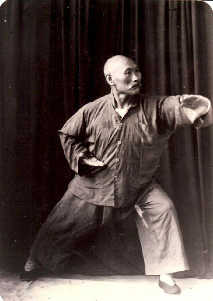"Fu Yonghui was born into a martial arts family... He followed his father [Fu Zhensong] in his travels around the country and met many famous martial arts teachers. He studied bajiquan with 'Magic Spear Li' (Li Shuwen) and Huo Dianyu. He studied Sun style taiji and push hands with Sun Lutang. He frequently went with his father to visit Li Jinglin, the founder of the Wudang Sword Method. He would get to see the military martial arts competitions and demonstrations, and learn the Wudang Sword Method from Li. When he was in Guangzhou he would get pointers from Yang Chengfu in Yang style taijiquan. He also received secret teachings in xingyiquan from Zhang Baofeng."
From `Notes on the chief transmitter of Fu style dragon form baguazhang, Fu Yonghui` by Lai Zonghong (translated by Joseph Crandall).
The Fu style is a complete system of Chinese exercise and self-cultivation, developed by Grandmaster Fu Zhen Song (Fu Chen Sung, 傅振嵩, 1881-1953). He was also known as Fu Qiankun (傅乾坤). The forms were further refined by his son, Fu Yong Hui (Fu Wing Fai, 1907-1993), and Fu Yong Hui's students such as Chen Leung in Hong Kong. It includes forms of tàijí quán (太極拳, t'ai chi ch'uan, tai chi), xing yi quan (形意拳, h'sing i ch'uan), ba gua zhang (八卦掌, pa kwa chang), liang yi quan (兩儀拳, "yin-yang boxing"), and weapon forms. As with all other internal styles, they are practiced solely for their health benefits nowadays by most practitioners.
From 1929 the Fus lived and taught in Guang Dong (Canton) and Hong Kong (Fu Wing Fai returned to Hong Kong when the cultural revolution broke out, after having spent time in Canton following Fu Zhen Song's death).
There are two main reasons this style is not as well knows as the styles promoted by the mainland government. Fu style was developed in the 20th century, when many disruptive events (eg war and multiple revolutions) affected China and interrupted teaching. Also, for political reasons (their support of General Sun and democratic government rather than for Mao and the communist style of government).
This type of exercise has many physical and mental health benefits, and for the long term practitioner can be used in self defence.
A 'complete system' is traditional Chinese terminology used to describe a style which contains multiple forms, and proceeds up to the highest level form. eg Shaolin kung fu's highest level form is 'iron wire palm' (sometimes 'iron wire fist'). Systems of kung fu which have an 'iron wire palm' form or equivalent are a complete system.
Fu Zhen Song was a grandmaster because he developed a complete system with logical coherence amongst its forms, proceeding up the the highest level form, Fu style dragon form baguazhang.
An 'internal' system is one which primarily focuses on training a person's 'internal' intrinsic energy. There are advantages to internal over external systems [1]. The disadvantage of the internal styles is the extreme difficulty of performing the movements exactly right (to the millimetre), without which they are much less effective. This precise whole-body coordination is also required to generate the spiralling force inside the body.
The 'three related' arts, tai ji, xing yi, and ba gua are all internal styles and, from the late 1800s, were often taught together. A common saying is 'tai ji goes from soft to hard and gung fu goes from hard to soft. The approach is different, the goal is the same'. All the internal styles rely upon utilizing the basic laws of physics, leverage and momentum. The Fu style in particular emphasizes directing the body's energy through the waist, using coiling power, and using 'rippling body' stepping. This trains the practitioner to use their body in a healthy manner and react correctly.
As the Fu style was mostly taught outside communist China during the period where these arts were suppressed on the mainland (1940s to 1970s) it was, in some linages, able to retain the essence of the internal systems. Like all talented people, Fu Zhen Song and Fu Wing Fai both continued to refine the system throughout their lives. Therefore, stylistic differences can be seen in different linages - this is especially evident with Fu Wing Fai's students from Hong Kong (where he lived 1966-1993) when compared to his earlier forms taught in Canton.
These days, Victor (Sheng Lung) Fu in Vancouver and Bow Sim Mak in Boston are the most well-known inheritors of the Fu style.
[footnote 1] It is impossible to reach the highest level (iron wire palm) in external styles if the person's training is begun beyond about 12 years of age, as the necessary hormones no longer exist in the human body after this age. Internal styles like tai chi do not rely upon these hormones to reach the highest level. So people can begin training at a later age and still potentially reach their birth potential [see "The Secrets of Chinese Meditation" by Lu K'uan Yu].
© Brett Mahar
site nginx on openbsd
